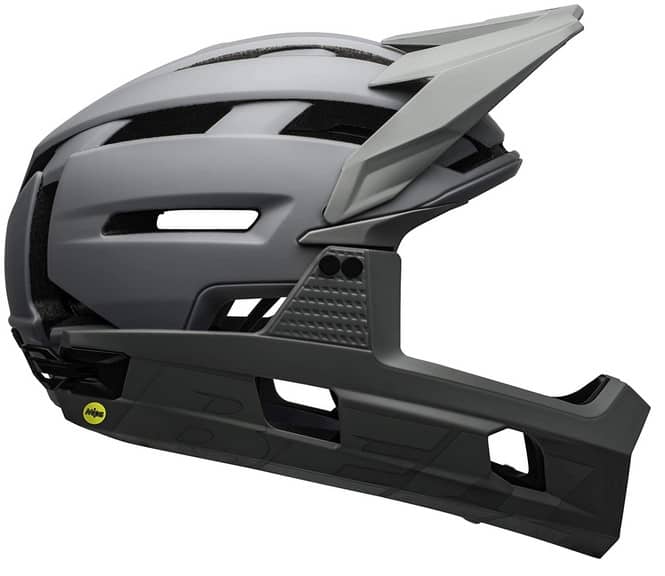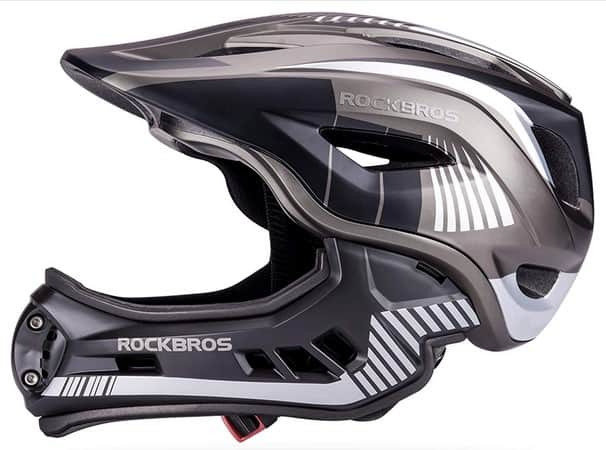According to a Science Direct meta-analysis, bicycle helmets reduce the risk of head injuries by 48% and facial injuries by 23%. If these statistics are anything to go by, a helmet is a must-wear, even for mountain bikers. But how do you decide between a full face vs open face helmet MTB?
A full-face helmet is best for aggressive and hardcore mountain bikers and trail riders, particularly in cold areas. In contrast, an open-face helmet is best for less aggressive trail riders, cross country racers, and casual mountain bikers, especially in hot spots.
These two helmets differ in weight, portability, breathability, comfort, and aerodynamics, among other ways. Below is a table breakdown of their actual differences, which I’ll share with you in detail:
| Full-Face Helmet | Open-Face Helmet | |
| Head Coverage | Full head coverage | It doesn’t cover the face |
| Helmet Weight | Slightly weighty | More lightweight |
| Portability | Less portable | More portable |
| Breathability | Less breathable | More breathable |
| Visibility | Only favors front visibility | Favors front and sideways visibility |
| Aerodynamics | Less aerodynamic | More aerodynamic |
| Comfort | Less comfortable | More comfortable |
| Safety Index | Safer than open-face | Slightly less safe |
| Cost | Costlier | More affordable |
| Rider Preference | Aggressive and hardcore mountain bikers and trail riders | Less aggressive trail riders, cross country racers, and casual mountain bikers |
| Region Suitability | Cool/cold regions | Hot/warm region |
The above table suggests at least 11 differences between the two bike helmets. Hopefully, the differences will help you choose the ideal MTB helmet.
Let’s get started!

Full Face Vs Open Face Helmet MTB – Detailed Comparison
Here are 11 factors that set full-face and open-face helmets apart:
1. Head Coverage
Full-face helmets, as the name suggests, promise full head coverage. These helmets cover the head and entire face, including facial features like the nose, eyes, chin, and forehead. Not even your ears or teeth are exposed when wearing a full-face helmet.
Open-face helmets, in contrast, have an open front, as the name hints. So, they don’t cover your face, which means they are less effective against frontal bike crashes.
The biggest miss in an open-face helmet is a chin guard, protecting the chin area. Most open-face helmets also don’t feature a visor, whose job is to protect your eyes.
In contrast, a full-face helmet forms a seal around your head, protecting your head and face from all angles. Plus, these mountain bike helmets have visors to protect your eyes.
2. Helmet Weight
An average open-face helmet weighs about 350g, while its full-face counterpart averages 800g. So, open-face helmets are lighter than full-face helmets.
Understandably, open-face helmets have an open front, resulting in less material use. As I discuss later, the low-weight advantage makes open-face more portable and comfortable.
3. Portability – Full Face Vs Open Face Mountain Bike Helmet
As I hinted earlier, an open-face helmet’s low weight makes it more portable than a full-face. It’s, however, not the only reason.
Most open-face helmets are also foldable, making their packing and transportation seamless. Hence, you can bring them wherever you go.
4. Breathability
While both helmets employ different ventilation technologies to promote breathability, an open-face helmet has a slight advantage, thanks to its open front. The open front means maximum natural ventilation, making them more suitable for hot weather.
Unfortunately, full-face helmets are prone to overheating as they are less breathable. However, it doesn’t apply to all, as some full-face helmets have more advanced ventilation technologies to make them highly breathable.
A case example is the Bell Super Air R MIPS Bike Helmet (View on Amazon), which employs overbrow ventilation to usher in cool air to cool your head under the sun.

5. Visibility – MTB Full Face Vs Open Face Helmet
Full-face helmets only favor front-forward visibility. It’s hard to look to the sides when wearing this helmet, which means you are less likely to be aware of your surrounding and respond to potential threats.
Overall, an open-face helmet offers the best visibility as it allows a sideways view. With it, you have at least a ¾ angle view.
6. Aerodynamics
While both helmets have some aerodynamic elements, open-face helmets are more aerodynamic. These helmets are associated with racing bikes, especially road bikes, and one of the bikes’ traits is being aero. So, if you want to go faster on an MTB, consider getting an open-face helmet.
7. Comfort
Some people find full-face helmets to be less comfortable because they are slightly weightier and less breathable. I’ve used the word ‘some’ because it doesn’t apply to all full-face helmets.
With the technology improving, helmets are making lighter and more breathable full-face helmets by the day.
Besides, there is more to comfort than just breathability and low weight. You also have to consider the lining, where most full-face helmets come with an EPS core that promises lots of cushioning.
8. Safety Index – Open Face Helmet Vs Full Face
According to a 2019 study by the Injury Epidemiology, which compared full-face and open-face helmets, the former offers the most head and facial protection, thus safer than the latter.
Comprehensibly, that’s because full-face helmets come with a chin guard, which is vividly missing on open-face helmets. As a result, full-face helmets protect the chin area when you don’t get such protection from open-face helmets.
Also, full-face helmets cover the face when open-face helmets don’t. That again confirms that full-face helmets are safer than open-face.
Besides, most full-face MTB helmets employ technologies like SPIN, WaveCel, and MIPS, which promise maximum impact redirection and absorption and keep you safe.
9. Cost
Since full-face helmets promise a higher safety index and are associated with hardcore MTB bikers, they cost more than open-face helmets. While you can get an open-face helmet for $50, a decent full-face helmet will cost you $150-$350, depending on the brand and the level of technology.
10. Rider Preference – Open Face Vs Full Face Helmet
We’ve two types of mountain bikers; hardcore riders and less-aggressive casual trail riders. Hardcore mountain bikers take greater risks, and so they need a full-face helmet to offer them full head coverage.
Less aggressive and caul trail riders, in contrast, need the most comfortable and lightweight helmet, and that’s where open face helmets come in.
11. Region Suitability
Since full-face helmets are heavier and generally less breathable, they are not best for hotter regions. On the contrary, they are best for cold-cooler areas as they easily retain heat to keep your head warm.
What’s more, they offer protection against biting insects, which means they are also more suitable for insect-prone regions.
Open-face helmets, in contrast, are best for hotter regions as they are highly breathable because of their open fronts. However, they are not the best for insect-prone areas as they don’t fully cover your head.

Full Face Vs Open Face Helmet MTB Pros and Cons
Full-Face Helmet
Pros
Full-face helmets generally enjoy these advantages:
- Safer than open-face helmets
- Effective against insects and bad weather
- Offers eye protection
- Best for hardcore mountain bikers
Cons
Full-face helmets suffer these drawbacks:
- Costlier
- Slightly heavy
- Less portable
- Less comfortable over long distance
- Only allows frontward visibility
Interested in the best full face MTB helmet? Below are worthy considerations:
- O’Neal Sierra II Men’s Slingshot Bike Helmet: Best for men
- Giro Switchblade MIPS Adult Helmet: Best for women
Open-Face Helmet
Pros
Open-face bike helmets promise these advantages:
- More breathable
- Lightweight and more portable
- Better visibility
- More aerodynamic
- More affordable
- Best for long-distance
Cons
Here are the drawbacks of open-face bike helmets:
- It doesn’t offer chin and face protection, thus making it less safe
- Offer little eye protection
- Not effective against insect bites
- Not suitable for colder environments
Interested in the best open face MTB helmet? Here are my hand-picked options:
- Giro Radix MIPS Men’s Mountain Cycling Helmet: Best for men
- Giro Verce MIPS Women’s Mountain Cycling Helmet: Best for women
Which Helmet Is Better Open Face or Full-Face?
Choosing between full-face and open-face helmets depends on the type of cycling and general weather.
A full-face helmet suits you more if you are an aggressive mountain biker or a hardcore trail rider. Moreover, it is best for cold and insect-prone regions as it offers complete head coverage.
Conversely, if you are a less aggressive trail rider, a cross country rider, or just a casual mountain biker, an open-face helmet suits you more as it’s more breathable and comfortable.
Additionally, an open-face helmet is best for hot regions as it enjoys more breathability for having an open front.

What if You Cannot Choose Between a Full Face and Open Face Helmet?
Considering that both full-face and open-face helmets have their fair share of goodies (and not forgetting the drawbacks), it might be hard to choose between them.
If that’s the case, you should opt for a full-face convertible helmet. Such full-face helmets come with a detachable chin guard, which you can remove to convert them into open-face helmets.
That means they are best for all-weather and all cycling styles.
People Also Ask
1. Do You Really Need a Full-Face Helmet?
You need a full-face helmet if you are a hardcore mountain biker or an aggressive trail rider who tackles different challenging terrains. You also need it if you ride in a cold and insect-prone zone, as the helmet promise full head coverage and protection.
2. Why Do You Need a Full-Face MTB Helmet?
A full-face helmet is necessary for providing full head coverage and protection. It’s safer than open-face helmets and generally suits aggressive and hardcore trail riders and mountain bikers.
3. Are Full Helmets Safer?
Full helmets generally cover the chin and the face more extensively and protect your head from all sides. As a result, full-faced helmets are much safer than open-face helmets. Their drawback is that they can be slightly uncomfortable long-distance.
Closing Thought On Full Face Vs Open Face Helmet MTB:
In conclusion, while full-face and open-face bike helmets promise different advantages to mountain bikers, full-face helmets have a higher safety index because they offer extensive head coverage. As a result, they suit aggressive and hardcore mountain bikers.
However, casual mountain bikers, XC fans, and trail riders can settle for open-face helmets as they are more affordable and offer them lots of freedom and comfort, despite having a lower safety index.